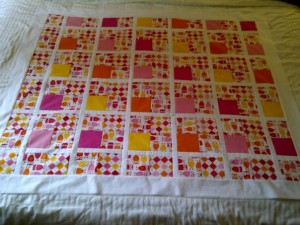A month ago, I had to suddenly and somewhat unexpectedly leave my teaching job to go on sick leave. Being pregnant, I knew that at some point this year I would be handing off my class to a stranger, but a big part of me was relying on having lots of notice that it was happening. I imagined a nice, smooth, calm transition where I would be able to give my students ample notice, sit with my replacement and give him or her lots of information on my students and their needs, talk to parents about it…
I definitely did not envision myself standing in front of my class with 20 minutes to the dismissal bell, tearfully telling them that I was sorry, but that I’d be back in the next day to say goodbye but would otherwise not be coming back until after my baby is born.
I had known for a few weeks that being ordered off work was a possibility, but I naively thought that my doctor would give me some kind of nebulous recommendation about going off work and leave the date up to me to decide. Instead, at a routine prenatal appointment on a Monday morning, he wrote me a note that said I would no longer be working as of that day. That day?! I wasn’t ready! My classroom was a disaster, I hadn’t finished marking, I hadn’t even taught things I needed to teach for the Progress Report yet, I hadn’t spoken to my students or their parents, I hadn’t even spoken to my colleagues or, more importantly, my administration!
Stubbornly, I waited until later that day to show the note to my principal and said that I would leave work at the end of the week, on Halloween. She shook her head and pointed to where it said “as of today,” explaining to me that the health of my child was paramount (as was my own) and that my students would be okay. I cried. I argued. I asked if I could please just be at work the next day so that I could get a proper goodbye in. She allowed me to come to work the next day, but not to teach. She had an OT come in for that day, and I spent the day getting things in order for someone to come in suddenly and jump into my class.
I had 20 minutes with my students at the end of the day on that Monday where I could tell them that I would be leaving and that it wasn’t my choice but that it was important for me to be at home and taking care of myself so that my baby and I would be healthy and safe. On the Tuesday, I popped in to see them throughout the day, answered their questions, and managed to get a goodbye in to everyone. They threw together a quick goodbye party for me and made me cry over and over with their kindness and generosity.
I’ve been off work now for four weeks. In that time, I have only been able to visit my class and my students once. This was partially due to time constraints and health, but partially because it’s important to me that they are able to move on and build a rapport with a new teacher.
I’m telling you this story because this experience has taught me several important lessons as a teacher. I’ll try to be concise as I explore them here.
1) Keep your classroom ready. I was fortunate to be of sound mind and healthy enough that I could stay after school those last two days and, with the help of my husband and some very generous colleagues, madly pack up the things I wanted to take home, throw away the things I had been meaning to throw away, and put away everything else in a place that a new teacher could come in and find them. It made me realize that had I gone into preterm labour, or had a major medical emergency of some kind where I could not come in at ALL, my classroom would have been a terrible experience for another teacher. It worked for me, but it didn’t work for anyone else. When I eventually return to work, I’ve learned that I need to keep my classroom in a state of relative readiness at all times so that should anything come up – even if I just need to be away for a day or two – another teacher will feel comfortable walking in and taking over.
2) Your students will be okay. I work hard to build a rapport with my students and I feel like I’m successful in reaching most of them. I am very invested in their success and well-being. It was very hard for me to pass off my class, especially so early in the year, to a teacher I didn’t know. It wasn’t that I didn’t think the new teacher could do a good enough job – it was that I worried about those young souls I left behind and if they would be able to engage with their new teacher. I worried about the ones who needed accommodations and whether they would advocate for themselves in my absence. I don’t deny that the transition was hard for some of my students, just as it is for them to adjust to me as their teacher at the beginning of the school year, and how hard it is for them to adjust to leaving my class at the end of the year. What I learned, however, is that students are flexible. They find things to relate to with their teachers. They find a way to fit a new personality and a new way of doing things into their lives. Will they like every teacher they ever have? No, of course not; to think that would be naive. But they will be okay, their needs will be taken care of, because deep down every teacher (I hope) has their students’ best interests at heart. We all have different styles, but we all want what’s best for our students, and they know that.
3) Crying in front of your students is okay, too. I am fairly certain that my students don’t think less of me because I was an emotional wreck those last two days. They don’t care that you didn’t wear makeup because you knew you were going to cry. They don’t care that you’re flustered and can’t find the right words to say. These things make you human. They make you “normal”. Accessible, in a way.
4) It’s okay to be honest with your students. I didn’t hide anything from them. I told them that my doctor had told me that I had to stop working because it was better for my baby (and me) to be at home resting. I assured them that nothing was wrong, but that this was just to make sure my baby could keep growing as long as possible. They appreciated the honesty. Had I just disappeared or left without giving them any detail, they would have been much more concerned. They were invested in the well being of my child because they cared about me. They were not distressed because I wasn’t distressed, I was just sad to leave.
5) You really, really, really need to disengage when you leave. For the first two weeks after I left work, I thought about it all the time. I cried more. I was upset that things weren’t the way I wanted. I checked my work e-mail constantly and was always texting my colleagues with things I had forgotten. This didn’t really help me “de-stress” the way I was supposed to. I still check my work e-mail once a day, because the official handover hasn’t happened yet and my long-term replacement only starts next week, but once she starts and we’ve had a chance to connect, I plan to reduce my work e-mail perusal to once a week (if that). Trust your colleagues to take care of your students in your absence. It’ll be alright.
I’m finally, four weeks in, embracing my time off. In a way I’m glad that I was sent off work early, because I can only imagine that being as upset as I was about it would have been ever harder if I was going through that while also caring for a newborn. It was very hard to let go and believe that everything would be okay. I still have moments where I think about individual students and how badly I wish I could be there for them, but I’m able to remind myself now that people are looking out for them.
We’ll see how I feel six months from now. 😉







